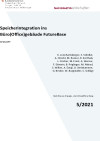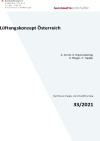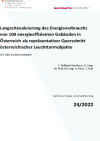Suchergebnisse
WEIZconnected - Gebäudeübergreifender Energieaustausch
Projektgegenstand ist die Konzeption, Entwicklung und Demonstration bzw. der Testbetrieb eines Gesamtsystems des gebäudeübergreifenden Energieaustausches (Strom) und der gebäudeintegrierten Produktion bei Gebäuden unterschiedlicher Nutzungsart (Gewerbe/Büro/Labor, Wohnbau). Zwei Pilotanlagen mit je unterschiedlichen Voraussetzungen und Zielen werden realisiert.
Sunny Energy Building: ENERGYbase - Bürohaus der Zukunft
Mit der Errichtung dieses zukunftsweisenden Kompetenzzentrums für Erneuerbare Energie setzt der Wiener Wirtschaftsförderungsfonds (WWFF) neue Maßstäbe bei der Entwicklung Energie optimierter Büroimmobilien. Auf 7.500 m² stehen Unternehmen sowie Forschungs- und Bildungseinrichtungen aus dem Zukunftsbereich der Erneuerbaren Energien modernste Büroflächen zur Verfügung.
DALEC - Day- and Artificial Light with Energy Calculation
Entwicklung eines Online-Konzeptanalysetool für ArchitektInnen, BauingenieurInnen, LichtplanerInnen und Bauherrn, welches trotz einer einfachen Handhabung und kurzen Berechnungszeiten, die komplexen lichttechnischen und thermischen Vorgänge in einem Gebäude abbildet und Heiz-, Kühl- und Kunstlichtbedarf anschaulich bewertet. Zudem wurde das Nutzerverhalten (z.B. Blendschutz) berücksichtigt und visuelle und thermische Komfortkriterien analysiert. Diese neuartige und innovative, gesamtheitliche Betrachtung ermöglicht eine nachhaltige und energieeffiziente Entwurfsplanung für Neubau und Sanierung.
THERM-opti-BALKON: Thermisch optimierte Balkonsanierung
Bei der thermischen Sanierung von Gebäuden stellen frei auskragende Balkone ein besonderes Problem dar. Das Projekt hatte zum Ziel, die Grundlagen für die Entwicklung eines praxistauglichen und kostengünstigen Befestigungssystems zu schaffen, das die thermisch entkoppelte Wiedererrichtung der Balkone im Zuge der Sanierung erlaubt und damit die Effizienz der Wärmedämmmaßnahme deutlich verbessert.
Energetic building refurbishment in protection zones

Standardized solutions as a help and guideline for building-owners, authorities and companies
Transferoffensive - Dem Passivhaus gehört die Zukunft

Von Pilotprojekten zum bewährten Baustandard mit optimalem Wohnkomfort - Große Transferoffensive zum Passivhausstandard mittels Messen und auf Gemeindeebene.
PH Office: Standard für energieeffiziente Bürobauten
Passivhäuser und energetisch hocheffiziente Bauweisen finden verstärkt auch im Bereich von Büro- und Dienstleistungsgebäuden ihre Anwendung. Gegenüber Wohnbauten ist die Standardisierung in form der Definition von konkreten Energiestandards für diese Gebäudekategorie aber noch nicht abgeschlossen. PH Office bringt Definitionen ein und erstellt einen Vorschlag für eine standardisierte Berechnungsmethode.
Speicherintegration ins Büro(Office)gebäude FutureBase (SPIN.OFF)

Im vorliegenden Projektvorhaben wurde in ein - in Planung befindliches - Bürogebäude ein Zink-Bromid Redox Flow Batteriespeicher integriert. Anhand dieser Demonstrationsanlage können Fragen, die bei der Integration und dem Betrieb von Batteriespeichern in gewerblichen oder öffentlichen Gebäuden auftreten, beantwortet werden.
Schriftenreihe
5/2021
K. Leonhartsberger, S. Schidler, A. Hirschl, M. Rosner, R. Korthals, L. Fischer, M. Ernst, A. Werner, F. Ettwein, B. Priglinger, M. Meisel, S. Wilker, A. Estaji, O. Stelzhammer, G. Becker, W. Burgstaller, S. Schlägl
Herausgeber: BMK
Deutsch, 139 Seiten
Downloads zur Publikation
Lüftungskonzept Österreich

Ziel des Projektes ist die Schaffung eines Nachweisverfahrens (auf Basis Microsoft-Excel), welches zeigt, ob eine natürliche Lüftung bzw. Fensterlüftung bei einer Standardnutzung zur Vermeidung von Schimmelbildung ausreichend, bzw. in Hinblick auf eine ausreichende hygienische Luftqualität zumutbar ist.
Schriftenreihe
33/2021
A. Greml, G. Rojas-Kopeinig, R. Pfluger, P. Tappler
Herausgeber: BMK
Deutsch, 87 Seiten
Downloads zur Publikation
M-DAB2: Materialintensität der Innenentwicklung - Ressourcenbewertung und Lokalisierung städtischer Entwicklungspotenziale
Bei der Bewertung von Innenentwicklungspotenzialen wurde erstmals auch die Materialintensität der Innenentwicklung (anfallende Stoffmengen) für unterschiedliche Entwicklungsvarianten berücksichtigt. Dabei wurde ein Methodenset zur holistischen Bewertung von Potenzialflächen und verschiedene Entwicklungsvarianten und -szenarien zur ressourcenschonenden Innenentwicklung geschaffen.
REGOreal - 100% Erneuerbare Energie Region: Lokale Energie Gemeinwohl Oekonomie im Reallabor für vernetzte Energie- und Mobilitätszellen
In REGOreal geschieht die Sondierung für eine 100% Erneuerbare Energieregion im Raum Retz-Horn-Krems-Tulln (NÖ) sowie Mallnitz (Ktn). Es gibt vier Fokusthemen: 100 Erneuerbare Energie-Gemeinschaften (EEG), 1.000 Gebäudesanierungen, 10.000 Energie-Exporteure und -Exporteurinnen (im Sinne der Mitarbeiter:innen, welche den Ansatz ins private Umfeld tragen) und 100.000.000 km nachhaltiger Mobilität mit umfassender Nutzung von IT für die Entwicklung lokaler integrierter Energyiesysteme (IES) zur Einbindung eines bunten Mix unterschiedlicher Akteure und Akteurinnen und Objekte.
Regelungstechnik für die Hausheizung der Zukunft

Durch Optimierung der Regelung von Biomassefeuerungen können Schadstoffemissionen und Energieverluste erheblich reduziert werden. Ziel der Projekts ist daher zunächst die Analyse derartiger Einsparungsmöglichkeiten anhand des zeitlichen Verlaufs des Wärmebedarfs verschiedener "Häuser der Zukunft". Aufgrund der Ergebnisse dieser Analyse wird ein optimiertes Regelungssystem entwickelt und anhand einer Biomassefeuerung erprobt.
Passivhauskindergarten Ziersdorf Phase Errichtung
Errichtung eines Kindergartens in Passivhaus-Technik unter Verwendung von lokal verfügbaren Baustoffen mit der Vorgabe eines streng limitierten Kostenrahmens
Refurbishment of a housing complex to passive-house standard, Graz - Dieselweg
Refurbishment of the former "Puch-Siedlung", built as a housing area for employees of the company "Puch", in Graz Liebenau, in the period from the 1950s to 1970s, as an exemplary model for a refurbishment in "passive house standard" with special thoughtfulness to the tenants. "From domestic fuel to solar self sufficiency"
Innovative regulation of thermal solar collectors
Research and development of the possibility of a "sensorless" regulation for thermal solar systems
Monitoring of multi-family houses “Tonpfeifengasse”
Evaluation of activated building parts as heat storage for renewable energy shown on the example of the multi-family houses "Tonpfeifengasse".
Langzeitevaluierung des Energieverbrauchs von 100 energieeffizienten Gebäuden in Österreich als repräsentativer Querschnitt österreichischer Leuchtturmobjekte (LZE 100 Leuchtturmobjekte)

Erfassung, Auswertung und Analyse von Energieverbrauchsdaten von 100 energieeffizienten Gebäuden in Österreich über eine Betriebszeit von 3 bis 25 Jahren als repräsentativer Querschnitt der österreichischen Leuchtturmobjekte. Differenzierung nach Gebäudetypen, Energieträger und Ermittlung der realen Treibhausgas-Emissionen. Vergleich der gemessenen Verbräuche zu Benchmark-Werten.
Schriftenreihe
24/2022
T. Roßkopf-Nachbaur, G. Lang, M. Ploß, M. Lang, A. Peter, T. Hatt
Herausgeber: BMK
Deutsch, 143 Seiten
Downloads zur Publikation
ProKlim - Prognosegesteuerte Gebäudeklimatisierung
Energieeffizienzsteigerung in der automatisierten Gebäudeklimatisierung durch wetterprognoseunterstützte Regelung
e80^3-Buildings - Sub project 2: Concept development
Based on the selection of suitable demonstration projects in Subproject 1 an innovative concept for passive and active building envelopes and energy supply of so called "Plus Energy Buildings" (renovation) has been developed.
Serielle Sanierung für Häuser in Leichtbauweise
Die Sanierung von Ein- und Zweifamilienhäusern in Leichtbauweise in Österreich bietet ein großes Potenzial zur CO2-Einsparung. In diesem Forschungsprojekt wurde ein Sanierungskonzept auf Passiv- bzw. Plus-Energiehausstandard entwickelt, welches auf Serienfertigung abzielt und besonderes Augenmerk auf die Verwendung ökologischer Baustoffe legt.
